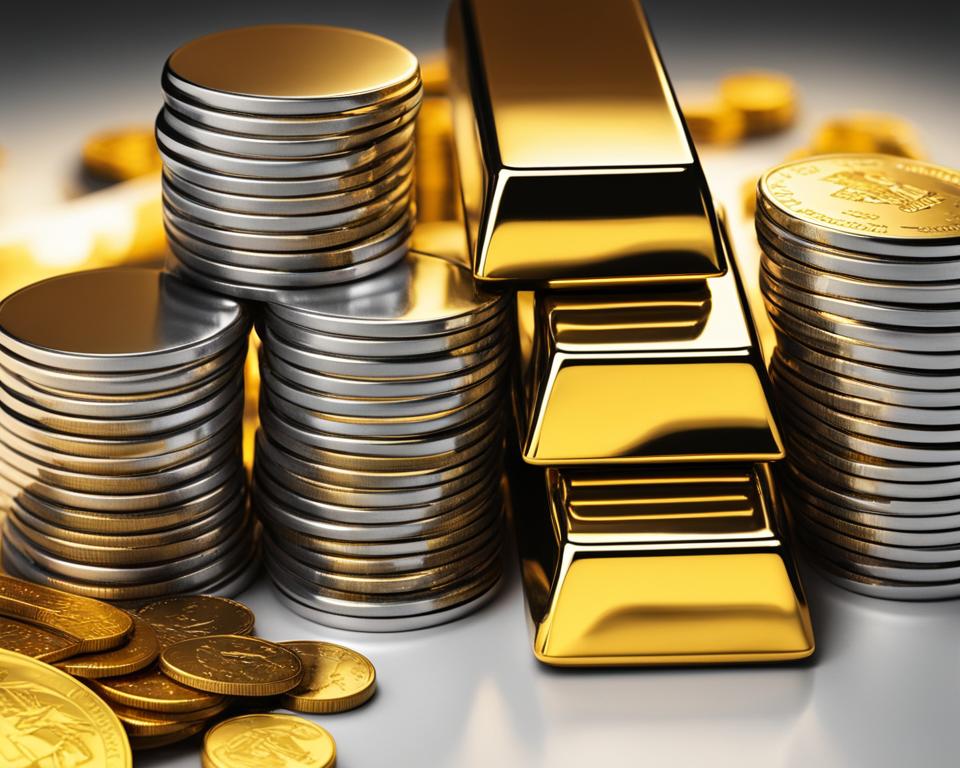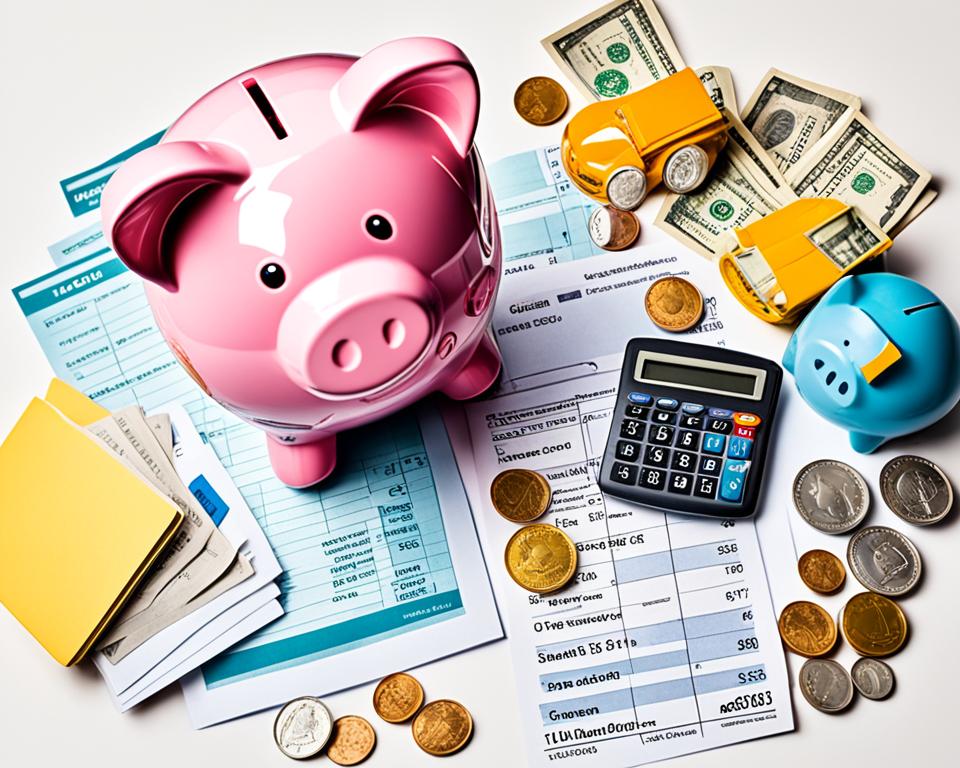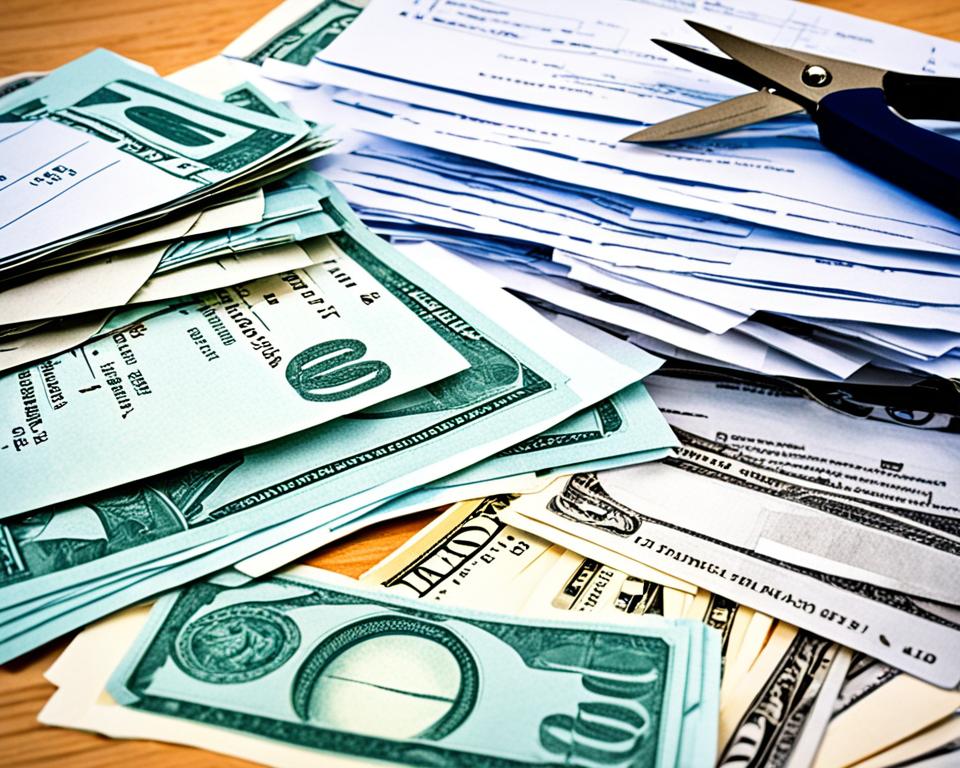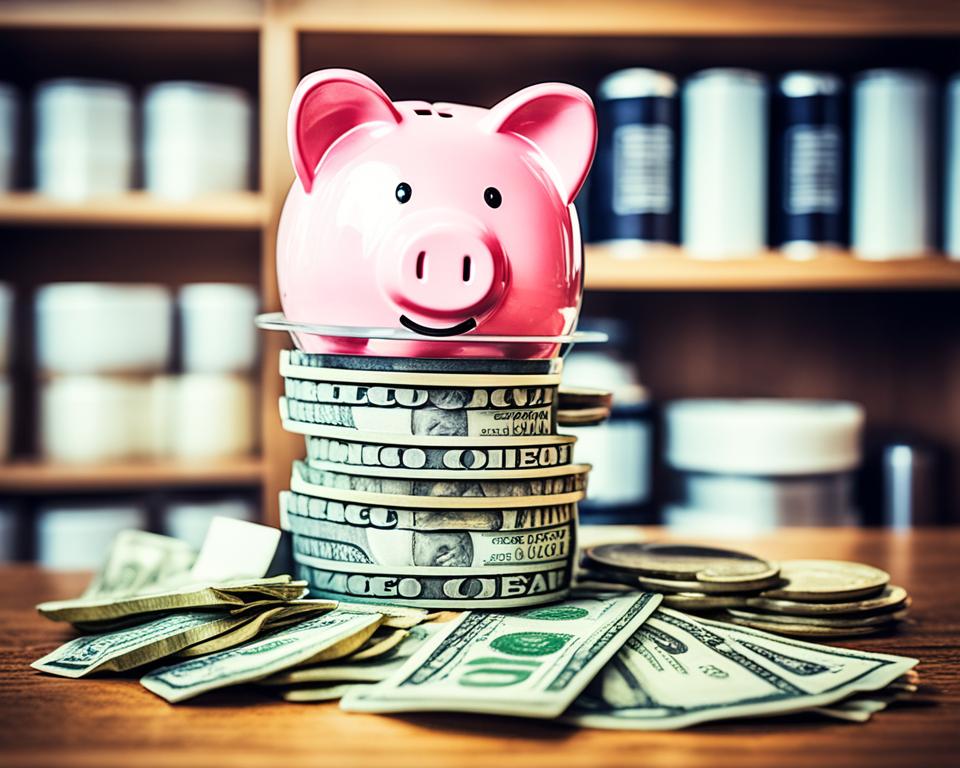Investing in precious metals can be a lucrative financial endeavor. Gold and silver, in particular, have been long-standing investments known for their ability to hold value and provide potential returns.
If you’re wondering whether you can make money by investing in precious metals, the answer is yes, but it’s essential to understand the intricacies of precious metal investing to make informed decisions.
Key Takeaways:
- Precious metals like gold and silver can be profitable investments.
- Understanding the fundamentals of precious metal investing is crucial.
- Consider factors such as market trends and historical performance.
- Diversify your investment portfolio with various precious metals.
- Be aware of the risks associated with investing in precious metals.
Why invest in precious metals?
Investing in precious metals can be a smart financial decision with numerous benefits. Precious metals, such as gold, silver, platinum, and palladium, have historically held their value well, making them a reliable investment option. These metals are also used across various industries, expanding their value beyond just jewelry. Here are some compelling reasons why you should consider investing in precious metals:
- Diversification and Stability: Precious metals offer a unique opportunity to diversify your investment portfolio. They typically exhibit low or negative correlation to other asset classes such as stocks and bonds. This means that investing in precious metals can help stabilize your portfolio during market volatility and economic uncertainty.
- Hedge against Inflation: Precious metals have historically proven to be effective hedges against inflation. As inflation erodes the purchasing power of fiat currency, the value of precious metals tends to rise. By investing in precious metals, you can protect your wealth from the erosive effects of inflation.
- Tangible Assets: Unlike stocks, bonds, or digital assets, precious metals are physical assets that you can hold in your hand. This tangibility provides a sense of security and ownership, making precious metals a preferred choice for many investors.
- Proven Store of Value: Throughout history, precious metals have served as a reliable store of value. They have maintained their worth over time and can be easily liquidated when needed.
- Potential for Long-Term Growth: Investing in precious metals can yield long-term growth opportunities. As global demand for these metals continues to rise, their scarcity and limited supply can drive their prices higher, potentially generating substantial returns on investment.
Investing in precious metals offers you the chance to make money while providing stability and diversification to your portfolio. Whether you are a novice investor or an experienced one, precious metals can play a crucial role in your overall investment strategy.
Investing in precious metals can provide numerous benefits for investors.
Types of Precious Metals
When it comes to investing in precious metals, there are several options to consider. The most common types of precious metals for investment purposes are gold, silver, platinum, and palladium. Each of these metals possesses unique characteristics and market factors that can influence their prices.
Gold, known for its durability and malleability, has been prized for centuries in both personal and commercial use. It is widely recognized as a symbol of wealth and is often used in jewelry, bullion, and coins.
Silver, on the other hand, has diverse applications beyond just jewelry. It is widely used in various industries, including electronics, solar panels, and photography. Its conductivity properties make it an essential component in many technological devices.
Platinum, rarer than gold or silver, is highly valued for its industrial usage, particularly in the automotive industry. It is used in catalytic converters, which help reduce harmful emissions from vehicles. Its scarcity and versatile properties contribute to its allure as an investment.
Palladium has important applications in electronics, dentistry, and catalytic converters as well. It is highly sought after for its ability to convert harmful gases into less toxic substances. The demand for palladium has been steadily increasing, making it an attractive investment option.
Each of these precious metals offers unique investment opportunities, with price fluctuations influenced by factors such as supply and demand, economic conditions, and geopolitical events.

“Investing in precious metals provides a tangible and valuable asset that can diversify your investment portfolio and serve as a store of value in uncertain times.”
How to Invest in Precious Metals
Investing in precious metals offers a range of opportunities to diversify your portfolio and potentially earn profits. There are multiple ways to invest in precious metals, depending on your investment goals and risk tolerance. Here are some common methods:
1. Investing in Coins and Bullion
Investing in physical forms of precious metals, such as coins and bullion, is a popular option for many investors. These tangible assets can be purchased from reputable dealers and provide you with ownership of the metals themselves. Coins and bullion are valued based on their metal content and can be stored securely as a long-term investment.
2. Mining Company Stocks and Mutual Funds
Another way to invest in precious metals is through mining company stocks and mutual funds. By investing in mining companies, you can gain exposure to the entire industry and benefit from the potential growth of these companies. Mutual funds that specialize in precious metals allow you to diversify your investment across multiple mining companies, reducing the risk associated with individual stocks.
3. Exchange-Traded Funds (ETFs)
Exchange-traded funds (ETFs) are investment products that trade on stock exchanges and offer exposure to precious metals. These funds hold a portfolio of precious metals or shares of companies involved in the production or distribution of precious metals. Investing in ETFs is a convenient way to gain exposure to the precious metals market, as they can be bought and sold like stocks.
4. Futures
Futures contracts are financial derivatives that allow investors to speculate on the future price of a particular precious metal. Futures trading requires a higher level of knowledge and experience, as it involves leveraging and sophisticated trading strategies. This method is more suitable for experienced or professional investors.
5. Individual Retirement Accounts (IRAs)
Individual retirement accounts (IRAs) provide individuals with the opportunity to invest in precious metals for their retirement savings. Precious metals IRAs allow you to hold physical metals within your retirement account, providing potential tax advantages and diversification for your retirement portfolio.
Choosing the right investment method depends on various factors, including your investment goals, risk tolerance, and knowledge of the market. It’s essential to conduct thorough research and consult with a financial advisor before making any investment decisions.
Precious metals prices
The prices of precious metals are influenced by various factors. Understanding these factors is essential for evaluating the potential profitability of investing in precious metals.
Scarcity and availability
Precious metals are finite resources that require extensive mining and processing. The limited availability of these metals contributes to their value and can impact their prices. When the supply of a particular precious metal is scarce, its price tends to rise. Conversely, if the supply increases or exceeds demand, prices may decrease. Therefore, monitoring the scarcity and availability of precious metals is crucial for investors seeking to capitalize on price fluctuations.
Natural events
Natural disasters such as earthquakes or hurricanes can have a significant impact on precious metal prices. Mining operations may be interrupted or damaged during these events, leading to a decrease in the supply of precious metals. Additionally, shipping delays due to adverse weather conditions can affect the delivery of metals to the market, further influencing prices. Investors should consider the potential impact of natural events on precious metal prices and adjust their investment strategies accordingly.
Geopolitical activity
Geopolitical events, such as political or economic instability in key producing countries, can affect precious metal prices. For example, if a major gold-producing country experiences political unrest or economic turmoil, it may disrupt mining operations and lead to a decrease in the global supply of gold. This reduction in supply can drive up prices. Geopolitical tensions, trade disputes, and changes in government policies can also impact investor sentiment and affect precious metal prices. Monitoring global geopolitical activity is crucial for investors looking to anticipate price movements.
| Factors Influencing Precious Metal Prices | Impact on Prices |
|---|---|
| Scarcity and availability | Influences supply and demand dynamics |
| Natural events | Can disrupt mining operations and affect delivery |
| Geopolitical activity | Creates uncertainties and affects investor sentiment |
By considering the interplay of scarcity and availability, natural events, and geopolitical activity, investors can gain valuable insights into the potential direction of precious metal prices. However, it’s important to note that the prices of precious metals are subject to various market forces and can be volatile. Conducting thorough research and staying informed about market developments is crucial for making informed investment decisions.
Advantages and Disadvantages of Investing in Precious Metals
When it comes to investing, precious metals offer several advantages that can enhance your financial portfolio. Let’s explore the benefits of investing in precious metals as well as the potential drawbacks.
Hedge against Inflation
One significant advantage of investing in precious metals is their ability to serve as a hedge against inflation. Precious metals like gold, silver, platinum, and palladium have historically shown a tendency to rise in value along with or above the inflation rate. This means that as the cost of living increases, the value of your precious metal investments can also increase, helping you maintain your purchasing power over time.
Tangible Asset
Precious metals, unlike stocks or bonds, are tangible assets that you can physically hold. This feature provides a sense of security, as you own something with inherent value that extends beyond investment purposes. Whether it’s gold bars, silver coins, or platinum bullion, these physical forms of precious metals offer a unique and tangible investment opportunity.
Portfolio Diversification
Another advantage of investing in precious metals is portfolio diversification. Precious metals often have different price movements compared to traditional assets like stocks and bonds. During times of economic uncertainty or market volatility, precious metals have historically performed well. By including precious metals in your investment portfolio, you can reduce the overall risk and enhance the stability of your investment strategy.
However, investing in precious metals also comes with certain disadvantages that you should consider.
Storage and Insurance
Physical precious metals require proper storage and insurance. Whether you decide to store them in a safe at home or secure them in a bank vault, you need to take precautions to protect your investment from theft or damage. Additionally, storing and insuring physical metals can incur additional costs, which can impact your overall investment returns.
No Income Generation
Unlike stocks or other investments that may generate income through dividends or interest payments, precious metals do not generate any income on their own. Their value primarily relies on market demand and scarcity. If you’re looking for investments that provide regular income, precious metals may not be the ideal choice.
Tax Implications
Finally, investing in precious metals can have tax implications, especially when you sell them for a profit. Depending on your country and jurisdiction, you may be subject to capital gains tax on the realized gains from selling your precious metal investments. It’s essential to understand and comply with the tax regulations relevant to your investments to avoid any potential penalties.
In summary, investing in precious metals offers advantages such as hedging against inflation, owning a tangible asset, and diversifying your portfolio. However, you should also consider the disadvantages, including storage and insurance costs, the lack of income generation, and tax implications. By carefully weighing these factors, you can make informed investment decisions and potentially benefit from the stability and potential growth that precious metal investments can offer.
| Advantages of Investing in Precious Metals | Disadvantages of Investing in Precious Metals |
|---|---|
| Acts as a hedge against inflation | Requires proper storage and insurance |
| Tangible assets with inherent value | No income generation |
| Diversifies investment portfolios | Tax implications when selling for a profit |
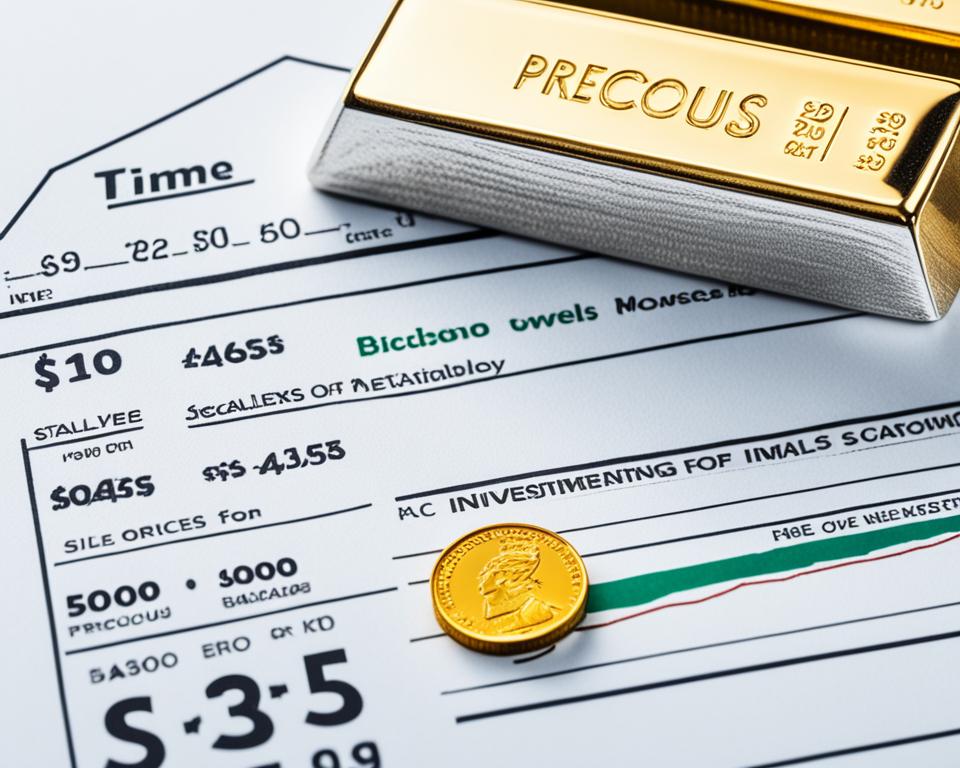
Risks of Investing in Precious Metals
Investing in precious metals can be a profitable endeavor, but it is essential to understand and evaluate the risks involved. By being aware of these risks, you can make informed investment decisions and mitigate potential losses.
Price Volatility
One of the primary risks of investing in precious metals is price volatility. The prices of metals like gold, silver, platinum, and palladium can be influenced by various factors, including changes in the overall economy, investor demand, and mining supply.
For example, during periods of economic stability or positive market sentiment, the demand for precious metals may decrease, leading to lower prices. Conversely, in times of economic uncertainty or market volatility, investors tend to flock to the safety of precious metals, driving up prices.
It’s important to note that price volatility can result in significant fluctuations in the value of your investments. Therefore, it’s crucial to have a long-term perspective when investing in precious metals and not be overly concerned with short-term price movements.
Risks Associated with Mining Company Stocks and ETFs
Another risk lies in investing in mining company stocks and exchange-traded funds (ETFs) that focus on precious metals. While these investment vehicles offer exposure to the precious metals industry, they also carry specific risks.
One such risk is the potential for cost overruns or financial issues within mining companies. These factors can negatively impact the profitability and value of mining stocks and ETFs. It’s important to thoroughly research and analyze the financial health and track record of mining companies to minimize these risks.
Impact of Cryptocurrency
The rise of cryptocurrency poses a potential risk to investing in precious metals. Cryptocurrencies, such as Bitcoin, have gained popularity as an alternative store of value and investment asset. Some investors may prefer cryptocurrency over precious metals, potentially reducing demand for metals and impacting their prices.
It’s essential to stay informed about developments in the cryptocurrency market and evaluate how it may affect the demand for precious metals. Diversifying your investment portfolio beyond precious metals can help mitigate this risk.
In Summary
Investing in precious metals offers the potential for wealth generation, but it’s crucial to be aware of the associated risks. Price volatility, risks related to mining company stocks and ETFs, and the impact of cryptocurrency can all influence the value of your investments.
By staying informed, conducting thorough research, and diversifying your portfolio, you can navigate these risks and make informed investment decisions in the precious metals market.
How to Invest in Specific Precious Metals
Investing in precious metals offers a range of opportunities to diversify your investment portfolio and potentially earn money. Each precious metal, including gold, silver, platinum, and palladium, has its specific investment options that you should consider. By understanding the various avenues for investment, you can create a well-rounded portfolio that aligns with your financial goals.
Investing in Gold:
When it comes to gold, you have several investment options to choose from:
- Gold Stocks: Consider investing in well-established gold mining companies like Newmont Mining or Barrick Gold Corporation. These stocks provide exposure to the gold market and benefit from potential increases in gold prices.
- Gold-focused ETFs: Exchange-Traded Funds (ETFs) such as SPDR Gold Shares (GLD) or iShares Gold Trust (IAU) offer investors the opportunity to gain exposure to gold prices without owning physical gold. These ETFs represent a fraction of an ounce of gold and track its price movements.
- Gold Mutual Funds: You can also invest in gold through mutual funds, such as Vanguard Precious Metals and Mining Fund or Tocqueville Gold Fund. These funds invest in a diversified portfolio of gold mining stocks.
Investing in Silver:
When it comes to silver, consider the following investment options:
- Silver Stocks: Look for silver mining companies like Pan American Silver or First Majestic Silver. These stocks provide exposure to the silver market and potential price appreciation.
- Silver-focused ETFs: Consider investing in ETFs like iShares Silver Trust (SLV) or Aberdeen Standard Physical Silver Shares ETF (SIVR), which track the silver price.
- Silver Mutual Funds: Invest in mutual funds that focus on silver, such as USAA Precious Metals and Minerals Fund or Invesco Gold and Precious Metals Fund. These funds provide diversified exposure to the silver market.
Investing in Platinum and Palladium:
For those interested in platinum and palladium, mining company stocks focused on these metals can be a way to invest:
- Platinum Stocks: Look for companies like Anglo American Platinum or Impala Platinum Holdings, which are major producers of platinum and offer exposure to the platinum market.
- Palladium Stocks: Explore stocks like Stillwater Mining Company or North American Palladium, which specialize in palladium mining and can provide exposure to the palladium market.
Remember, each precious metal investment option has its own risks and potential returns. It’s essential to conduct thorough research and assess your risk tolerance before investing in these specific precious metals. Diversifying your portfolio with a combination of gold, silver, platinum, and palladium investments can help mitigate risk and enhance the potential for profit.
| Precious Metal | Investment Options |
|---|---|
| Gold |
|
| Silver |
|
| Platinum | Platinum Stocks |
| Palladium | Palladium Stocks |
Best Precious Metals to Invest In
When it comes to investing in precious metals, there are specific stocks within each category that stand out as lucrative opportunities. Whether you’re interested in gold, silver, platinum, or palladium, here are some of the top stocks to consider:
Gold Stocks
1. First Majestic Silver: With a focus on silver and gold mining, First Majestic Silver is a solid choice for investors looking to capitalize on the rising demand for precious metals.
2. Franco-Nevada: As one of the leading gold mining companies globally, Franco-Nevada offers investors exposure to a well-diversified portfolio of mining assets.
3. Newmont Mining: Known for its extensive experience and expertise in gold mining, Newmont Mining is a reliable option for investors seeking stability and potential growth in the gold market.
Platinum and Palladium Stocks
1. Sibanye-Stillwater: As a major producer of platinum and palladium, Sibanye-Stillwater presents a compelling investment opportunity. Its strong industry presence and diversified operations make it an attractive choice for investors.
Precious Metals Streaming Company
1. Wheaton Precious Metals: Wheaton Precious Metals is a significant player in the precious metals streaming industry. By providing upfront funding to mining companies in exchange for the right to purchase precious metals at a predetermined price, they offer a unique investment avenue with potential for substantial returns.
These stocks represent some of the best options for investors looking to invest in specific precious metals. By conducting thorough research and considering market trends, you can make informed decisions and potentially optimize your investment portfolio.
Precious Metals Investing Considerations
When it comes to investing in precious metals, there are important considerations to keep in mind to make informed decisions that align with your investment thesis. These considerations involve evaluating the risks associated with different investment vehicles and understanding the potential outcomes.
Your investment thesis is the reason behind your decision to invest in precious metals. It encapsulates your goals, expectations, and desired outcomes. Before diving into the investment process, take the time to clarify why you want to invest in precious metals and determine what you hope to achieve.
The Risks of Different Investment Vehicles
Each investment vehicle has its own set of advantages, disadvantages, and associated risks. Understanding these risks is crucial for evaluating the suitability of each option to your investment strategy. Here are some key risks to consider:
The first risk to consider is the potential for underperformance. Stocks and exchange-traded funds (ETFs) that track the precious metals market can be affected by various factors, including market conditions and company-specific issues. It’s important to carefully analyze historical performance and market trends to gauge the potential for growth or decline.
Another consideration is physical storage costs. If you opt for physical forms of precious metals like coins and bullion, you’ll need to factor in storage and insurance costs. These expenses can impact the overall profitability of your investment.
Tax implications are also important to take into account. When selling precious metals, you may be subject to capital gains taxes. Understanding the tax laws and regulations relevant to your jurisdiction can help you optimize your investment returns.
Evaluating the Considerations
When investing in precious metals, carefully evaluate these considerations to minimize risks and maximize returns. Here’s a step-by-step guide to help you make informed investing decisions:
- Define your investment thesis: Clearly articulate the purpose, goals, and desired outcomes of your precious metals investment.
- Research different investment vehicles: Gain an understanding of the pros, cons, and risks associated with each investment option, such as physical assets, mining company stocks, or ETFs.
- Assess potential risks: Analyze the risks specific to each investment vehicle, such as underperformance, storage costs, or tax implications, and evaluate their impact on your investment strategy.
- Diversify your portfolio: Consider diversifying your investment portfolio by including other asset classes alongside precious metals. This can help mitigate risks and enhance long-term returns.
- Monitor market conditions: Keep a close eye on market trends, geopolitical events, and economic indicators that can influence the value of precious metals.
- Stay informed: Continuously educate yourself on the precious metals market, industry news, and regulatory changes to adapt your investment strategy accordingly.
By considering these factors and evaluating the risks associated with different investment vehicles, you can make well-informed decisions that align with your investment thesis and increase your chances of successful precious metals investing.
Conclusion
Investing in precious metals can be a profitable venture for enhancing wealth. Gold, silver, platinum, and palladium offer unique advantages as tangible assets that hold value and provide diversification. These precious metals have a long history of serving as a store of value and can act as a hedge against inflation. They also have diverse industrial applications, making them valuable beyond just jewelry.
However, it’s important to consider the risks and market factors that can influence prices. Price volatility, geopolitical activity, and supply and demand dynamics are all important factors to monitor. By understanding the different investment options, such as physical metals, mining stocks, ETFs, and IRAs, investors can make informed decisions that align with their investment goals.
Overall, investing in precious metals can be an attractive addition to an investment portfolio. But like any investment, it requires careful consideration and research. By evaluating the advantages and disadvantages, understanding market factors, and staying informed, you can potentially earn money by capitalizing on the opportunities presented by precious metal investments.
FAQ
Can you make money by investing in precious metals?
Investing in precious metals can be a sound financial decision for several reasons. Precious metals tend to hold their value well and have proven to be one of the best stores of value historically. They also have diverse industrial applications, making them valuable beyond just jewelry. Understanding the different types of precious metals, investment strategies, and market factors that influence prices is important for making informed investment decisions and potentially earning money through precious metal investments.
Why invest in precious metals?
Investing in precious metals offers several benefits. Precious metals tend to hold their value well because they are scarce and fixed resources. They can be used in many different industries and have diverse applications beyond just jewelry. Precious metals are tangible assets that offer stability in times of economic uncertainty. They also provide a hedge against inflation and can diversify your investment portfolio. These factors make investing in precious metals a potential avenue for making money and enhancing wealth.
What are the types of precious metals?
The most common types of precious metals for investment purposes are gold, silver, platinum, and palladium. Gold is a durable and malleable metal with numerous applications in both personal and commercial use. Silver is used in various industries, including electronics and solar panels. Platinum is rarer than gold or silver and has extensive industrial usage, particularly in the automotive industry. Palladium has important applications in electronics, dentistry, and in catalytic converters. Each of these precious metals has unique characteristics and market factors that can influence their prices.
How can you invest in precious metals?
There are several ways to invest in precious metals. One option is to invest in physical forms like coins and bullion, which can be purchased from reputable dealers. Another option is to invest in mining company stocks and mutual funds, which provide exposure to the precious metals industry. Exchange-traded funds (ETFs) are investment products that allow investors to gain exposure to precious metals through shares of companies or physical metals. Futures contracts are available for more experienced or professional investors. Additionally, individual retirement accounts (IRAs) offer the opportunity to invest in precious metals for retirement savings.
What factors influence precious metals prices?
The prices of precious metals are influenced by various factors. Scarcity and availability play a significant role, as precious metals are finite resources that require extensive mining and processing. Natural events, such as earthquakes or hurricanes, can also impact prices by affecting mining operations or causing shipping delays. Geopolitical activity, such as political or economic instability in key producing countries, can also affect prices. Understanding these factors is essential for evaluating the potential profitability of investing in precious metals.
What are the advantages and disadvantages of investing in precious metals?
Investing in precious metals offers several advantages. They can serve as a hedge against inflation, as their prices tend to rise along with or above the inflation rate. Precious metals are tangible assets that hold value beyond investment purposes. They provide portfolio diversification, as their price movements often differ from those of stocks and bonds. However, there are also disadvantages to consider. Physical metals require storage and insurance, and there is a potential for theft. Precious metals don’t generate income, and there are tax implications when selling them at a profit.
What are the risks of investing in precious metals?
Investing in precious metals carries certain risks. Price volatility is a significant risk factor, as prices can be influenced by changes in the economy, investor demand, and mining supply. Investments in mining company stocks and ETFs also carry specific risks, such as cost overruns or financial issues. Additionally, the rise of cryptocurrency poses a potential risk, as it competes with precious metals as a store of value. Understanding these risks is important for making informed investment decisions.
How can you invest in specific precious metals?
Each precious metal has specific investment options. For gold, investors can consider investing in gold stocks, gold-focused ETFs, or gold mutual funds. Silver can be invested in through silver stocks or silver-focused ETFs and mutual funds. Platinum and palladium offer investment opportunities through mining stocks that focus on these metals. Understanding the specific investment options for each precious metal is crucial for building a well-rounded portfolio.
What are the best precious metals to invest in?
Within each precious metal category, there are specific stocks that investors can consider. For gold, top gold mining stocks include First Majestic Silver and Franco-Nevada. Newmont Mining is a leading gold mining company. Sibanye-Stillwater is a major producer of platinum and palladium. Wheaton Precious Metals is a significant player in the precious metals streaming industry. These stocks represent some of the best options for investors looking to invest in specific precious metals.
What should you consider when investing in precious metals?
When investing in precious metals, it’s important to consider your investment thesis. Determine why you want to invest and what you hope to achieve. Each investment vehicle has its pros, cons, and associated risks, such as physical storage costs, potential underperformance of stocks or ETFs, and tax implications. Evaluating these considerations is crucial for making informed investing decisions.

